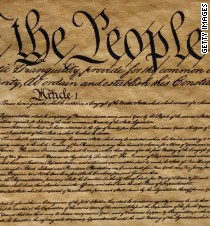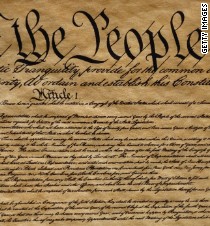US Constitution Fast Facts

(CNN)Here’s a look at United States Constitution, which establishes and sets forth the ultimate law of the land.
The Constitution is comprised of a preamble, seven articles and 27 amendments (last addition in 1992).
The first three articles of the Constitution sets up the federal system by dividing power between three branches of government – the legislative, executive and judicial. The Fourth and Tenth Amendments insure states’ rights and separate the federal and state governments.
Federal powers listed in the Constitution include the right to collect taxes, declare war and regulate trade. The federal government has implied powers that allow the government to respond to changing needs of the nation.
Reserved powers, as dictated by the Tenth Amendment, belong to the states or the people. State powers include the right to legislate on divorce, marriage and education. The right to own property and the right to be tried by a jury are powers reserved for the people.
In some cases, there are concurrent powers, where both the federal and state governments may act. The federal government has authority in case of a conflict.
Final authority in the interpretation of the Constitution lies with the Supreme Court. It can overturn any law that conflicts with any part of the Constitution.
The Constitutional Convention:
May 25, 1787 – The Constitutional Convention meets in Philadelphia to discuss revising the Articles of Confederation. They decide instead to write the Constitution of the United States, and hold secret meetings with sentries posted outside the doors.
May 25, 1787 – The Constitutional Convention meets in Philadelphia to discuss revising the Articles of Confederation. They decide instead to write the Constitution of the United States, and hold secret meetings with sentries posted outside the doors.
Twelve of the 13 states send delegates to the Constitutional Convention. Rhode Island does not send delegates because it does not want a national government to interfere with its affairs.
George Washington serves as president of the convention. Other delegates include: Benjamin Franklin, Alexander Hamilton, James Madison, John Dickinson, Gouverneur Morris, Edmund Randolph, Roger Sherman, James Wilson and George Wythe.
The oldest delegate is Benjamin Franklin, 81, of Pennsylvania and the youngest is Jonathon Dayton, 26, of New Jersey.
September 17, 1787 – Thirty-nine of the 55 delegates sign the Constitution of the United States. Each state holds a Constitutional Convention and once nine states ratify the Constitution, the new government can begin.
June 21, 1788 – New Hampshire is the ninth state to ratify the Constitution, therefore putting it into effect. However, New York and Virginia had not yet ratified the Constitution and these states’ acceptance was necessary for the Constitution to work.
June 25, 1788 – Virginia ratifies the Constitution.
July 26, 1788 – New York ratifies the Constitution.
Bill of Rights:
The promise of a Bill of Rights helped the Constitution get ratified in several important states.
The promise of a Bill of Rights helped the Constitution get ratified in several important states.
The amendments in the Bill of Rights were written to protect individual liberties against possible unjust rule by the national government.
James Madison suggested 15 amendments; Congress accepted 12 to be submitted to the states. Ten were approved by the states and added to the Constitution as the Bill of Rights.
December 15, 1791 – The Bill of Rights goes into effect.
Constitutional Amendments:
An amendment may be proposed by two-thirds of each house of Congress, or by a national convention called by Congress in response to requests by two-thirds of the state legislatures.
An amendment may be proposed by two-thirds of each house of Congress, or by a national convention called by Congress in response to requests by two-thirds of the state legislatures.
It becomes part of the Constitution after being ratified either by the legislatures of three-fourths of the states or by conventions in three-fourths of the states.
Congress decides which form of ratification should be used and how much time the states have to consider each amendment.
The process of amending the Constitution was designed to be difficult.
Amendments:
Amendment 1 – Freedom of religion, speech, and the press; rights of assembly and petition – proposed September 25, 1789; ratified December 15, 1791
Amendment 1 – Freedom of religion, speech, and the press; rights of assembly and petition – proposed September 25, 1789; ratified December 15, 1791
Amendment 2 – Right to bear arms – proposed September 25, 1789; ratified December 15, 1791
Amendment 3 – Housing of soldiers – proposed September 25, 1789; ratified December 15, 1791
Amendment 4 – Search and arrest warrants – proposed September 25, 1789; ratified December 15, 1791
Amendment 5 – Rights in criminal cases – proposed September 25, 1789; ratified December 15, 1791
Amendment 6 – Rights to a fair trial – proposed September 25, 1789; ratified December 15, 1791
Amendment 7 – Rights in civil cases – proposed September 25, 1789; ratified December 15, 1791
Amendment 8 – Bails, fines and punishments – proposed September 25, 1789; ratified December 15, 1791
Amendment 9 – Rights retained by the people – proposed September 25, 1789; ratified December 15, 1791
Amendment 10 – Powers retained by the states and the people – proposed September 25, 1789; ratified December 15, 1791
Amendment 11 – Lawsuits against states – proposed March 4, 1794; ratified February 7, 1795
Amendment 12 – Election of the president and vice president – proposed December 9, 1803; ratified July 27, 1804
Amendment 13 – Abolition of slavery – proposed January 31, 1865; ratified December 5, 1865
Amendment 14 – Civil rights – proposed June 13, 1866; ratified July 9, 1868
Amendment 15 – Black suffrage – proposed February 26, 1869; ratified February 3, 1870
Amendment 16 – Income taxes – proposed July 12, 1909; ratified February 3, 1913
Amendment 17 – Direct election of senators – proposed May 13, 1912; ratified April 8, 1913
Amendment 18 – Prohibition of liquor – proposed December 18, 1917; ratified December 16, 1919
Amendment 19 – Woman suffrage – proposed June 4, 1919; ratified August 18, 1920
Amendment 20 – Terms of the president and Congress – proposed March 2, 1932; ratified January 23, 1933
Amendment 21 – Repeal of prohibition – proposed February 20, 1933; ratified December 5, 1933
Amendment 22 – Limitation of presidents to two terms – proposed March 24, 1947; ratified February 27, 1951
Amendment 23 – Suffrage in the District of Columbia – proposed June 16, 1960; ratified March 21, 1961
Amendment 24 – Poll taxes – proposed August 27, 1962; ratified January 23, 1964
Amendment 25 – Presidential disability and succession – proposed July 6, 1965; ratified February 10, 1967
Amendment 26 – Suffrage for 18-year-olds – proposed March 23, 1971; ratified July 1, 1971
Amendment 27 – Congressional salaries – proposed September 25, 1789; ratified May 7, 1992
Read more: http://www.cnn.com/2013/10/31/us/u-s-constitution-fast-facts/index.html
